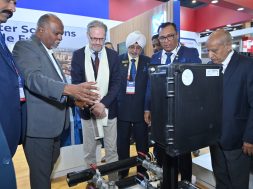Mighty Buildings and Honeywell enhance 3D-printed homes with eco-friendly insulation

Mighty Buildings enhances environmentally friendly 3D printing, improving insulation and reducing emissions with Honeywell’s Solstice® LBA.
Honeywell (NASDAQ: HON) announces that a crucial element of the substance Mighty Buildings uses to construct 3D-printed homes is Honeywell Solstice® Liquid Blowing Agent (LBA). Honeywell’s low-GWP technology will take the place of conventional foam insulation, enabling Mighty Buildings to create robust, energy-efficient building panels while lowering emissions. The partnership with Mighty Buildings helps Honeywell better connect its product line to three significant megatrends, one of which is the energy transition.
According to a recent estimate by the UN Environment Programme, 37 percent of greenhouse gas emissions worldwide are attributable to the building and construction sector. Since Solstice LBA has a GWP that is 99.9 percent lower than other blowing agents that are frequently used in construction, it has the potential to lessen the environmental effect of the industry.
“When used with our patented 3D-printing technology, Solstice LBA will enable us to build comfortable and climate-resistant housing,” says Scott Gebicke, CEO, Mighty Buildings. “The construction industry needs fast, safe and reliable alternatives to traditional building materials. By incorporating Solstice into our production process, we can further enhance the performance and sustainability of our 3D-printed products while reducing the construction industry’s overall carbon footprint.”
The 3D-printed panels developed using Solstice LBA will be manufactured at Mighty Buildings’ production facility in Monterrey, Mexico. The facility currently has capacity to print enough panels for two homes per day, and Mighty Building’ total construction time for a 3D-printed home is often less than a week. Once complete, these homes require less energy for heating and cooling than those built with other commonly used blowing agents due to Solstice LBA’s ability to provide better thermal insulation.
“Honeywell offers a range of solutions to help customers reach their emissions reduction and energy efficiency goals,” says Jeff Dormo, president of Honeywell Sustainability and Decarbonisation. “Our Solstice technology is constantly being used in new ways, and by offering a non-ozone depleting, nonflammable and high-performance foam blowing agent, our work with Mighty Buildings has the potential to transform the future of homes and the building and construction industry as a whole.”
Honeywell Solstice LBA is includes in the Significant New Alternatives Policy (SNAP) program of the Environmental Protection Agency. This program encourages the creation and use of substitute materials for ozone-depleting ones.
Over $1 billion is being spent by Honeywell on research, development, and building new facilities for its Solstice technology, which is currently used in solvents, blowing agents, aerosols, and refrigerants. It is also being considered for possible expansion into metered dose inhalers. Utilising Honeywell Solstice technology, it initially became available in 2011, has prevented the potential emission of almost 94 million gasoline-powered passenger vehicles’ worth of carbon emissions annually, or more than 395 million metric tonnes of carbon dioxide, into the atmosphere.
For more details, visit: https://advancedmaterials.honeywell.com/
Cookie Consent
We use cookies to personalize your experience. By continuing to visit this website you agree to our Terms & Conditions, Privacy Policy and Cookie Policy.









